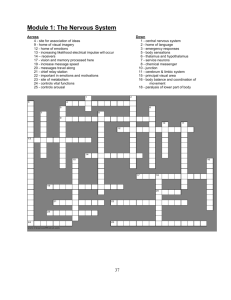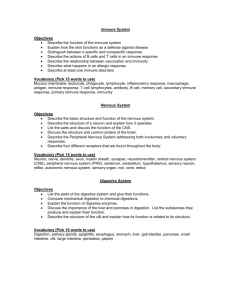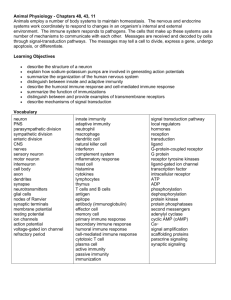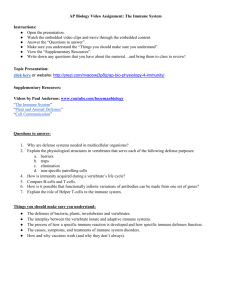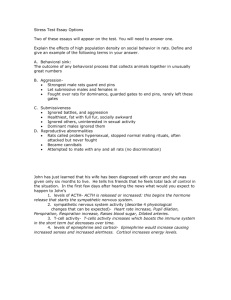Name: AP Biology: Ch. 40, 43, & 45 Study Guide Chapter 40
advertisement
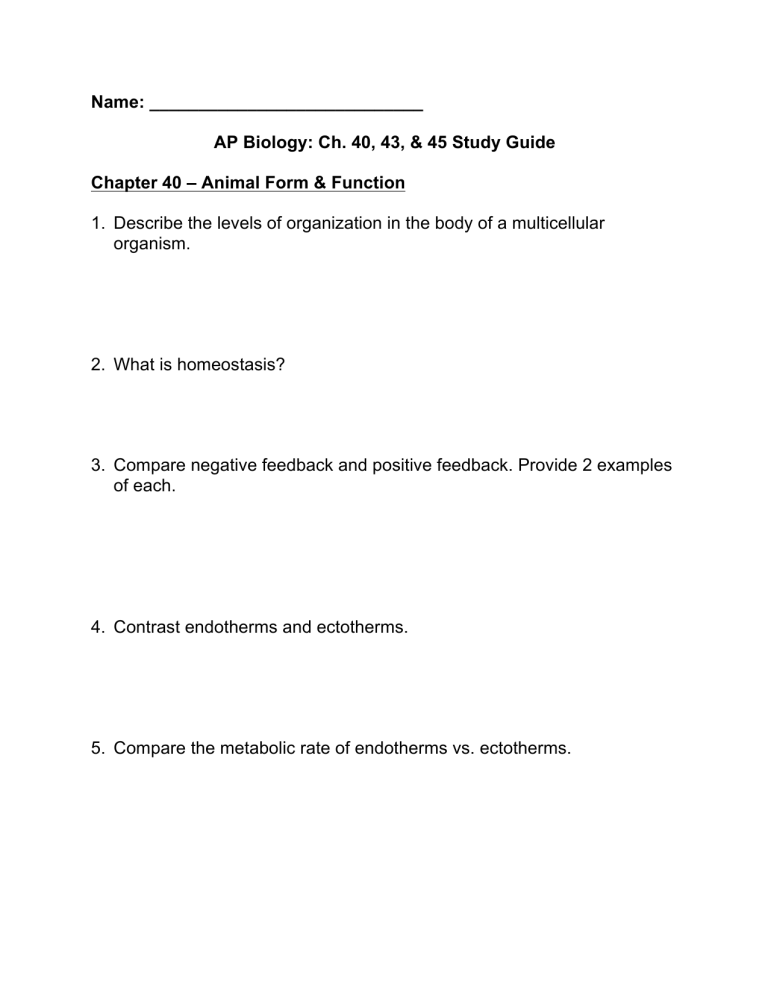
Name: ____________________________ AP Biology: Ch. 40, 43, & 45 Study Guide Chapter 40 – Animal Form & Function 1. Describe the levels of organization in the body of a multicellular organism. 2. What is homeostasis? 3. Compare negative feedback and positive feedback. Provide 2 examples of each. 4. Contrast endotherms and ectotherms. 5. Compare the metabolic rate of endotherms vs. ectotherms. 2 6. Define the following terms: a. Torpor b. Hibernation c. Estivation Chapter 43: The Immune System Terms to know Barrier defenses Lysozyme Neutrophils Eosinophils Macrophage Dendritic cells Interferon Complement system Inflammatory response Histamines B cells T cells Antigens Antibodies Clonal selection Memory cells Antigen-presenting cells MHC molecules Primary immune response Secondary immune response Humoral immune response Cell-mediated immune response Helper T cells Cytotoxic T cells Plasma cells Vaccine Allergies HIV 1. Describe the various elements of an innate immune response. 2. How are antigens recognized by immune system cells? 3 3. Compare B and T cells. (Where are they made? Matured? How are they activated? What are their actions?) 4. Describe differences in humoral and cell-mediated immunity. 5. Why are Helper T cells central to immune responses? 6. What is the role of antibodies in the immune system? 7. How do vaccines work? 4 8. Compare a primary immune response to a secondary immune response. 9. Explain the biological mechanisms that lead to the rejection of transplanted organs. Chapter 45 – Endocrine System 1. What are hormones? 2. List the two main types of hormone receptors. Describe the location of each type, and examples of hormones that bind to each type. a. b. 3. How are the hypothalamus and pituitary gland related? 4. Describe how blood glucose levels are regulated in the body. 5 5. What is diabetes? Describe the 2 main types of diabetes. 6. For each of the following hormones, list the gland that secretes the hormone, the target cells, and the action it causes. Hormone: Secreted By: Target Cells: Action: Oxytocin Antidiuretic hormone (ADH) Folliclestimulating hormone (FSH) Luteinizing hormone (LH) Insulin Glucagon Epinephrine 7. What are the effects of the release of epinephrine on the body during a fight-or-flight situation? List the types of cells/tissues affected and the effects of epinephrine on them. 6 Chapter 48 & 49 – Neurons & the Nervous System Terms to know: Neuron Sensory neuron Epinephrine Cell body Interneuron Norepinephrine Dendrite Motor neuron Dopamine Axon Nerve Serotonin Myelin sheath Membrane GABA Schwann cells potential Reflex arc Glia Resting potential Cerebrum Synapse Nerve impulse (forebrain) Neurotransmitter Action potential Brainstem Synaptic Threshold (midbrain) terminal Depolarization Cerebellum CNS Refractory period (hindbrain) PNS Saltatory Sensory conduction receptor Acetylcholine 1. Compare the central nervous system (CNS) to the peripheral nervous system (PNS). 2. Draw and label a neuron. What is the function of dendrites, cell body, axon, synapse, and myelin sheath? 3. Define membrane potential and resting potential. 7 4. What is the main cation inside the cell? Outside the cell? 5. How is a nerve impulse transmitted in a neuron? 6. Describe the mechanism of saltatory conduction. 7. Describe the process that leads to release of neurotransmitters, and what happens at the synapse. 8. Describe the action of acetylcholine. 8 9. Explain how the nervous system functions to respond to an external stimulus. 10. Describe the structure and function of the following parts of the brain: a) Cerebrum b) Cerebellum c) Brainstem d) Medulla oblongata e) Corpus callosum Label the Brain.


